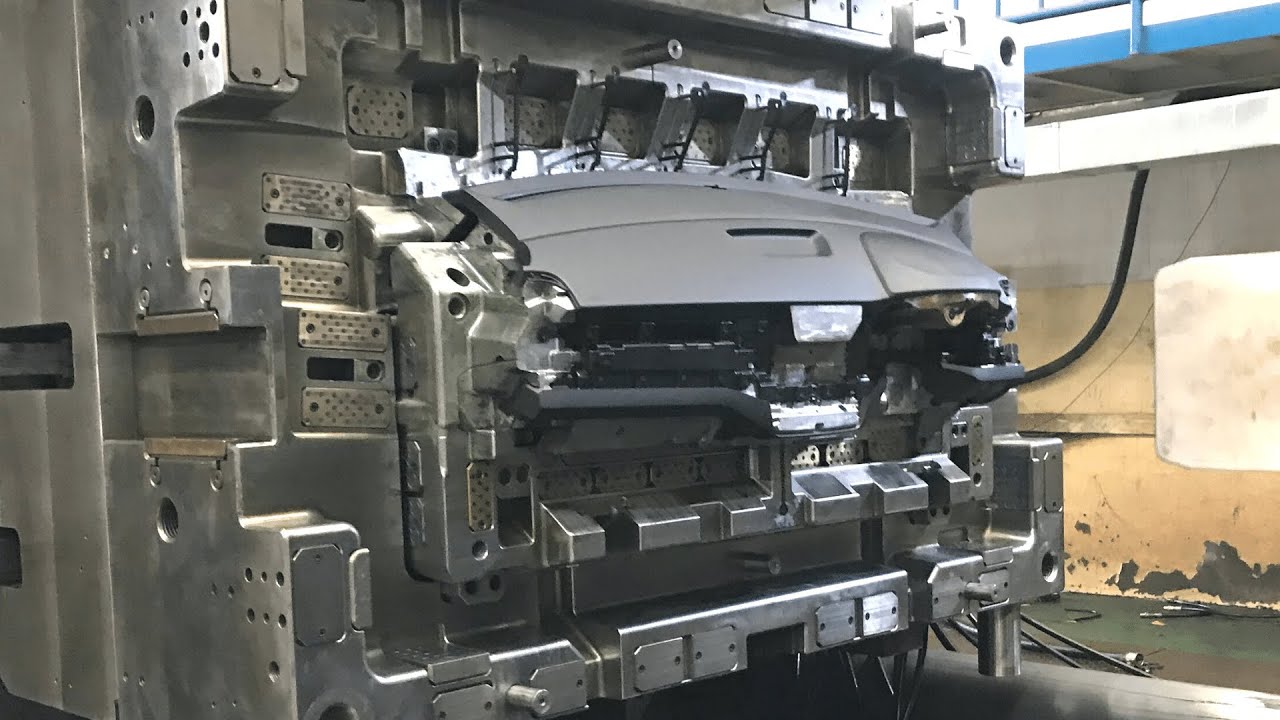Что такое литье под давлением крупных деталей?
Литье под давлением крупных деталей - это тип процесса литья под давлением, используемый для производства крупных пластиковых деталей. Как и все технологии литья под давлением, он осуществляется путем впрыска расплавленного пластика в полость формы под сильным нагревом и давлением. По мере застывания пластик затвердевает, принимая форму пресс-формы.
Литье под давлением крупных деталей отличается от обычного литья под давлением размером деталей, которые он может производить. Используя более крупные машины и пресс-формы, эта технология позволяет с относительной легкостью создавать массивные детали размером в несколько футов.

Почему необходимо литье под давлением крупных деталей
Стандартные машины для литья под давлением создают усилие смыкания от 50 до 500 тонн. Это позволяет им производить детали небольшого и умеренного размера, используя пресс-формы с небольшой площадью поверхности.
Однако при литье таких объемных деталей, как промышленные резервуары, подстилки для грузовиков или корпуса байдарок, требуется значительно большее давление смыкания. Для производства крупногабаритных деталей требуются формы с большей площадью поверхности и повышенное усилие смыкания для удержания формы закрытой от повышенного давления впрыска.
Машины, разработанные специально для литья под давлением крупных деталей, обеспечивают усилие смыкания 500+ тонн. Некоторые мегатонные машины могут оказывать давление более 4 000 тонн! Только с помощью такой грубой силы можно отливать колоссальные компоненты.
Что считается "крупной частью"?
В сфере производства пластмасс "крупная деталь" - это скорее неофициальное обозначение, чем точная спецификация. Тем не менее, специалисты отрасли склонны относить к крупным детали весом более 20 фунтов.
Аналогичным образом, любой компонент, хотя бы один из размеров которого превышает 30 дюймов, как правило, требует оборудования для литья под давлением крупных деталей. Тем не менее, небольшие детали также могут считаться "крупными", если для их успешного производства требуются машины грузоподъемностью 500+ тонн.
Машины для литья под давлением крупных деталей
Для успешного литья крупных деталей требуется очень мощное оборудование. Машины для литья под давлением крупных деталей обладают такими определяющими характеристиками:
- Гигантские платины - Подвижные "пластины", обеспечивающие усилие зажима, имеют огромные размеры, часто 8 x 8 футов или больше.
- Мощные зажимные устройства - Гидравлические цилиндры, создающие усилие запирания от 500 до более чем 4 000 тонн.
- Высокая мощность выстрела - Бочки, в которых хранятся сотни фунтов расплавленного смола.
- Большие формы - Огромная оснастка весом до 50 000 фунтов.
- Прочная конструкция - Усиленная конструкция выдерживает огромные повторяющиеся нагрузки.
Это крупногабаритное оборудование позволяет производить такие огромные детали, как корпуса для байдарок, промышленные химические резервуары диаметром 120 дюймов, подстилки для грузовиков и бункеры для сельскохозяйственных кормов, превышающие размеры джакузи!
Специальные требования
Для запуска мегатонного оборудования для литья пластмасс требуется обширная инфраструктура и вспомогательное оборудование:
- Удобства - Заводы должны вмещать машины размером 40 x 15 x 15 футов и весом до 160 тонн!
- Мощность - Специальные электрические системы обеспечивают огромную мощность, необходимую этим гигантам.
- Обработка пластмасс - Конвейерное оборудование перемещает смолы из железнодорожных вагонов и грузовиков с сыпучими материалами.
- Обращение с плесенью - Мостовые краны поднимают и размещают пресс-формы весом 50 000+ фунтов.
- Обработка деталей - Вилочные погрузчики и паллетные домкраты перемещают громоздкие детали.
- Вторичные операции - Линии окраски, станции тампонной печати украшают крупные детали.
Процесс литья под давлением крупных деталей
Хотя используются экстремальные размеры и усилия, основной процесс остается схожим с обычным литьем под давлением. Вот последовательность действий:
1. Зажим
Для начала две половины формы закрываются и с силой сжимаются плитами машины. Направляющие стержни обеспечивают правильное выравнивание при закрытии формы.
2. Инъекция
Затем узел впрыска расплавляет пластиковую смолу и впрыскивает ее в форму через литник. Жидкий пластик проходит через бегунки, которые направляют его в каждую щель полости.
3. Охлаждение
По каналам, прорезанным в оснастке, циркулирует вода с регулируемой температурой, охлаждая пластик. По мере застывания детали слегка отходят от стенок формы.
4. Выброс
Наконец, плита открывается, детали выталкиваются с помощью штифтов, и пресс-форма закрывается для повторения цикла.
На станках регулярно формуются детали, размеры которых превышают максимальные пределы зажимного устройства. Время цикла составляет от 45 секунд до пяти минут в зависимости от размера детали и других факторов.
Области применения литья под давлением крупных деталей
Тяжелая промышленность использует крупногабаритные формованные компоненты для решения многочисленных задач:
- Обработка материалов - Тотализаторы, контейнеры, ящики, гайлорды, баки, кейсы.
- Транспорт - Вкладыши для грузовиков, крылья для тракторов, резервуары для фургонов.
- Сельское хозяйство - Бункеры для семян, резервуары для жидкости, корпуса шнеков.
- Строительство - Бетонные формы, башни для укрепления траншей, заградительные стены.
- Жидкостная сила - Корпуса клапанов, резервуары, фитинги, коллекторы.
- Отдых - Корпуса для каяков, капоты для снегоходов, полы для прицепов для лошадей.
К пластику предъявляются такие общие требования, как устойчивость к атмосферным воздействиям, прочность, стабильность и амортизация.
Все, что требует многократного производства огромных деталей, находит преимущества в пропускной способности литья под давлением. Тяжелая промышленность по всему миру зависит от сверхразмерных пластиковых компонентов!
Основные выводы по литью под давлением крупных деталей
- Это разновидность литья под давлением, при котором используется крупногабаритное оборудование для производства гигантских пластиковых деталей.
- Вес и размеры определяют, что считать "крупной деталью".
- В этих процессах используются термопластавтоматы с усилием смыкания 500+ тонн.
- Область применения - промышленные резервуары, подстилки для грузовиков, корпуса байдарок и многое другое.
- Несмотря на экстремальность ситуации, в основе лежит подход, напоминающий обычное литье под давлением.
Поэтому для изготовления огромных пластиковых деталей, исчисляемых сотнями единиц, литье под давлением для крупных деталей - самый подходящий метод!
